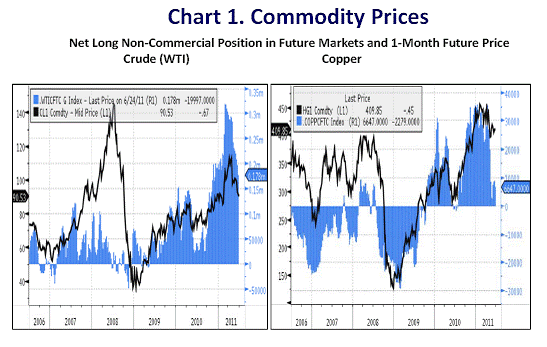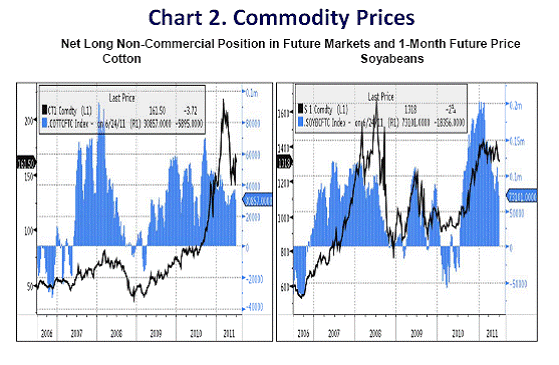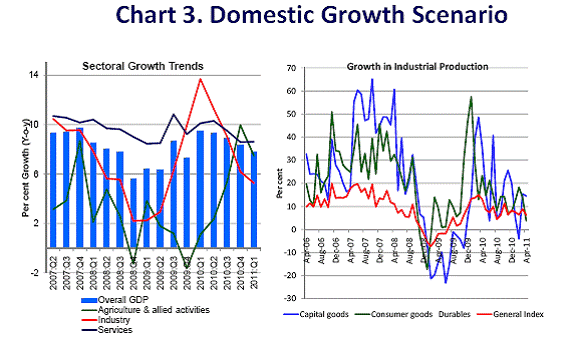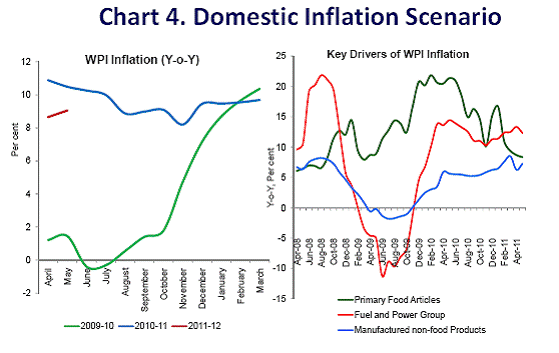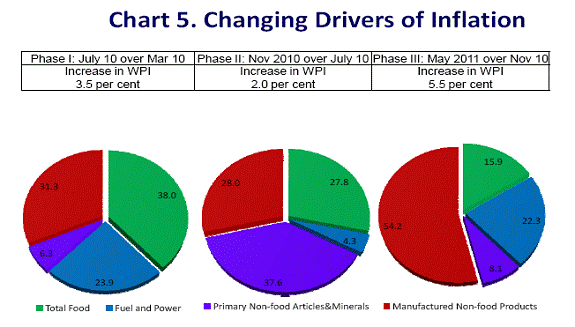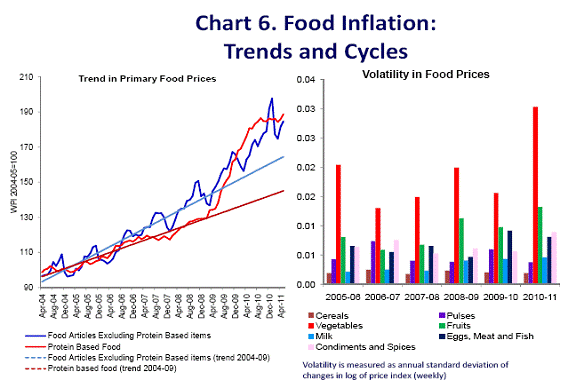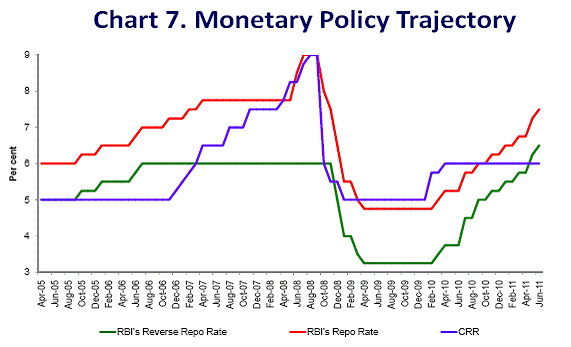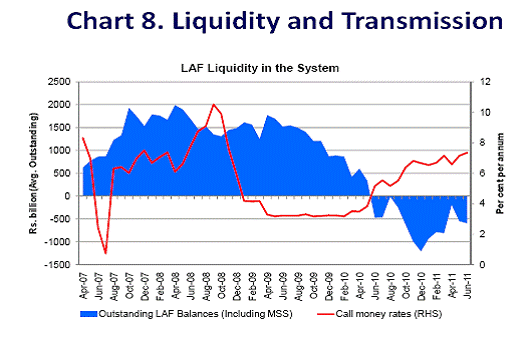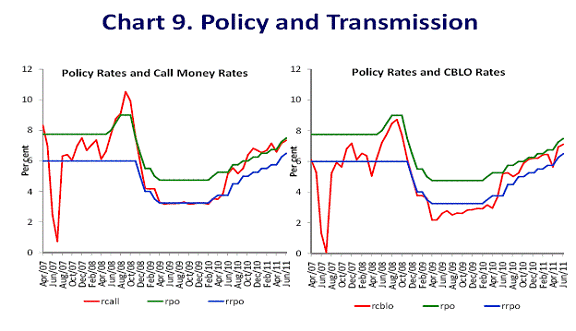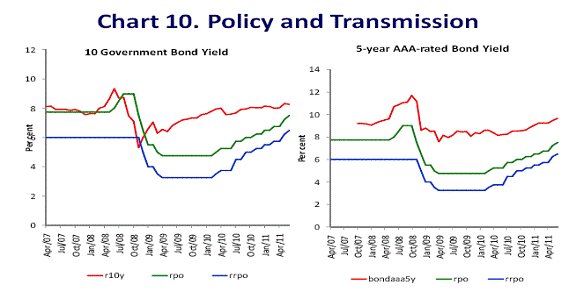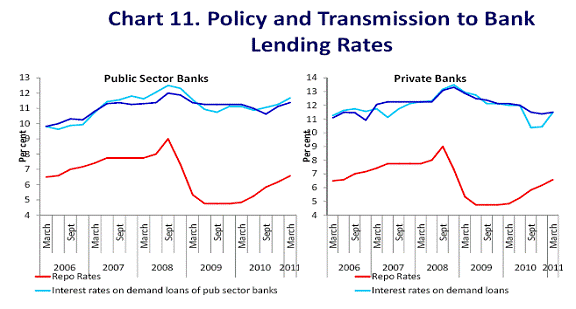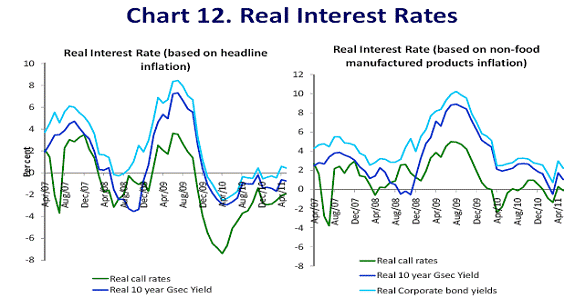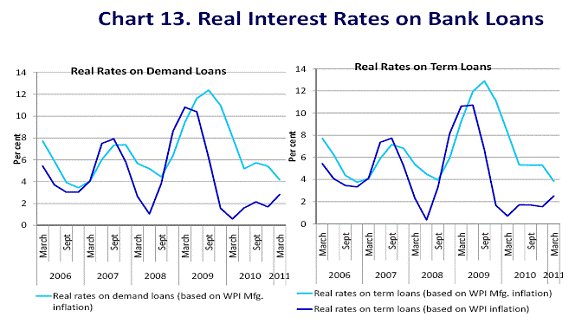Striking the Balance between Growth and Inflation in India - RBI - Reserve Bank of India


Striking the Balance between Growth and Inflation in India
Dr. Subir Gokarn, Deputy Governor, Reserve Bank of India
Delivered on Jul 07, 2011
Striking the Balance between Growth and Inflation in India* I. Introduction The Indian economy recovered relatively quickly from the financial crisis of 2008, but inflationary pressures emerged even in the early stages of the recovery in late 2009. Over the past year and a half, the challenge for monetary policy has been to contain these inflationary pressures without disrupting the recovery. The economy grew by 8.5 per cent in the fiscal year 2010-11, which is close to the five-year average pre-crisis, but year-end headline inflation was over 9 per cent, well above tolerance limits. Meanwhile, global developments have implications for both growth and inflation trajectories in India over the coming months. In this presentation, I propose to talk about the key global and domestic factors that are shaping our growth and inflation outlook, as a backdrop to discussing monetary policy actions and their impact. I will then briefly talk about challenges to communication. II. Global Forces There are widespread perceptions and increasing concerns about the recovery in the advanced economies losing momentum. High energy prices appear to be feeding into a negative cycle of persistent unemployment and depressed housing prices in the US and UK, while the prospect of sovereign default and its real and financial consequences dominates the European policy discussion. In contrast, emerging Market Economies (EMEs) are showing symptoms of demand-driven inflationary pressures, which have, over the past several months, been exacerbated by rising global commodity prices. Apart from all the other things that are going on in the global environment, commodity prices have played a key role in India's inflation over this period. Consequently, their likely trajectory is going to be an important factor in influencing India's inflation path. Charts 1 and Chart 2 provide some perspective on this. They display the correlations between the build-up of non-commercial long positions in four commodities - crude oil, copper, cotton and soya beans - and price movements. It appears that that trading positions, possibly driven by abundant liquidity, are contributing to recent price escalations, except in cotton, where temporary supply disruptions have been the main factor. Significantly, in recent weeks, there has been a reversal in long positions, which in turn is associated with softening of prices. If this trend persists, it will provide substantial relief for global inflation management, particularly for large commodity importers, including India. Further, although hardly a desirable way to control inflation, slowing global growth, in addition to reinforcing these favourable commodity price trends, will also help to moderate demand and keep capacity utilization low. This will contribute to moderating inflationary pressures coming from traded or tradable goods. III. Domestic Growth Prospects 2010-11 was a year in which the economy continued its recovery from the impact of the financial crisis. Growth bottomed out at 6.8 per cent in 2008-09, the crisis year, picked up to 8 per cent in 2009-10 and further to 8.5 per cent in 2010-11. Chart 3 shows two pictures of the growth trajectory. With reference to aggregate and sectoral Gross Domestic Product (GDP) estimates, the trajectory in the graph suggests that the momentum is moderating somewhat, as the most recent quarters show decelerating year-on-year growth rates. The main contributor to this tendency is the industrial sector, which has shown relatively high volatility over the period displayed. It slowed significantly during the crisis, recovered sharply subsequently and has recently begun to slow down. Looking at the industrial sector a little more closely, the graph displaying trends in industrial production provide some clues to its dynamics. The most volatile segments of the index, both of which are displayed on the graph, are capital goods and consumer durables. These are generally seen as being the most interest-sensitive components of the index and their recent trends suggest that the impact of contractionary monetary policy is having an impact. Along with softening commodity prices, this trend will contribute to bringing inflation under control, by helping moderate demand pressures. Of course, industry associations, including Confederation of Indian Industry (CII), have been consistent critics of the monetary policy stance, arguing that it is slowing growth without really impacting inflation, which is being driven by supply side pressures. I will address this critique both in the discussion on inflation and the one on communication. In short, the domestic growth scenario suggests that the growth rate will moderate somewhat in the coming year. The Reserve Bank of India projects growth during 2011-12 to be 8 per cent in its baseline scenario. From the inflation management perspective, this is not an entirely undesirable outcome. If it results in a significant reduction in the inflation rate, it will represent a soft landing, which in turn opens up the opportunity for a reversal in the interest rate cycle. However, many unknowns stand in the way and ultimately, inflation outcomes will determine the monetary stance. IV. Domestic Inflation Dynamics Over the past year, the nature of inflation has changed in significant ways. Chart 4 provides a broad picture of the dynamics. Headline inflation began to accelerate in the second half of 2009-10, at a time when growth was still relatively sluggish. It stayed high through 2010-11, actually accelerating in the last quarter of the year. In the first two months of 2011-12, that pattern has persisted. However, the relative importance of the drivers of inflation clearly changed over the period displayed. Food inflation was the predominant contributor in the early phase, but a resurgence of energy prices in the post-crisis environment began to play an increasingly important role. The prices of non-food manufactured products, which the RBI views as a reflection of demand pressures, began to rise noticeably in early 2010, but saw their rate of increase stabilize and even moderate somewhat in the third quarter of 2010-11. However, that pattern was short-lived and the rate of inflation for this category surged in the fourth quarter, a momentum that has clearly persisted into the current year. The changing contributions of different drivers are very sharply brought out in the decomposition exercise displayed in Chart 5. The analysis looked at recent patterns in terms of three periods of roughly equal lengths over the past 14 months, beginning April 2010. In the first period, food and energy, reflecting classic supply-side forces, were the primary contributors to inflation. Non-food manufacturing inflation, which, to the extent that it represents demand pressures, was not insignificant, suggesting that pricing power was present. In the second period, the weight of the contribution shifted dramatically towards commodities other than energy. The contribution from food moderated a bit, as did that from non-food manufacturing, suggesting that the pass-through or "generalization" risk was moderating. However, this pattern was short-lived. In the last period, energy returned as a major contributor and the sharp increase in the contribution of non-food manufacturing indicated that producers were able to pass on higher input costs without too much difficulty. The strength of the pass-through in this period indicated that demand conditions remained quite robust, even as some early signs of moderation were coming through the production estimates and feedback from industry. I want to put particular emphasis on food price dynamics, as I believe that this is likely to be a significant factor in the medium term. Although the overall contribution of food to inflation moderated over the past year, there are structural demand-supply imbalances at work, which will keep the pressure up in the absence of large and sustainable increases in supply. This phenomenon is demonstrated in the graph in Chart 6. The main point that the graph makes is that the prices of protein sources have deviated sharply from their trend in recent years and show no signs of reverting to it. By contrast, the prices of other foods have also shown periodic deviations from trend, but have generally reverted. This pattern has, of course contributed to high volatility, as the Chart also demonstrates. Volatility in food prices does have a welfare-reducing impact, but in the current Indian context, the much greater concern is the long-term nutritional impact of elevated protein prices. At a time when the combined impact of demographic transition and income increases is generating enormous demand for proteins, the supply chain is clearly struggling to meet this demand. To conclude this part of the discussion, let me bring in the issue of inflationary expectations. The persistence and recent acceleration of inflation has clearly increased the risk of expectations becoming unanchored. The RBI monitors short-term expectations through household surveys. Recent surveys have reinforced the perception that household expectations are moving up. Food prices play an important role in this process, but whatever the causes, the impact on wage-setting in both explicit and implicit contracts cannot be dismissed. However, the relative stability of long-term (10-year) yields on government securities suggest that expectations over this horizon remain anchored. This is reinforced by our regular surveys of professional forecasters, which also indicate no loss of confidence in a moderate inflation scenario over the medium and long run. V. Monetary Policy : Actions and Transmission The current cycle of contractionary monetary policy was initiated in the context of two important factors. First, there was an enormous volume of liquidity in the domestic financial system, as a result of policy responses to the crisis, which also took policy rates to very low levels. Second, even as the early signs of recovery were visible, inflationary tendencies had also begun to show. All this was happening in a global environment which was still quite turbulent and uncertain in late 2009 and early 2010. Chart 7 shows the trajectory of policy instruments - the Repo, the Reverse Repo and the Cash Reserve Ratio (CRR) in the pre-crisis, crisis and recovery periods. In contrast to the very sharp and quick actions on rates and liquidity that were taken in responding to the crisis, the recovery has been characterized by a much more calibrated approach. This was motivated by considerations related to the factors that I mentioned earlier. A more aggressive response to the incipient inflationary pressures may have been warranted under somewhat more predictable domestic growth and global scenarios, but in both these respects the situation in early 2010 was nowhere near stable or predictable. A calibrated approach, which was essentially a relatively frequent series of small rate hikes, was seen as the best way to balance the potentially conflicting objectives. In the early phase of the cycle, surplus liquidity conditions persisted, which, clearly made transmission of policy rates through to transaction rates very sluggish. From this perspective, the early actions were essentially a signaling effort, accompanied by steady moves to eliminate the liquidity surplus through CRR increases. By the middle of the 2010, the liquidity scenario had moved to a deficit and transmission became much stronger. Chart 8 shows the immediate impact on the call rate, which is effectively the operating target of monetary policy, of a change in the liquidity situation. The strengthening of transmission was visible across a variety of financial market segments. Charts 9 and Chart 10 provide some illustrative evidence of this. In Chart 9, the call and Collateralized Borrowing and Lending Operations (CBLO) rates, a secured short-term channel of liquidity management, are shown with reference to the repo-reverse repo corridor. The transmission intensity is quite clear, with the added dimension of movement from the lower bound of the corridor to the upper bound, as liquidity conditions tightened. Chart 10 shows the yield on 10-year government securities and that on 5-year AAA corporate bonds from the same perspective. Transmission is visible here as well. Of course, the banking system is by far the more important intermediary in the Indian financial context and what banks do matters a great deal. Significantly, a similar analysis of transmission through bank lending rates does not suggest that it is as strong as that in markets. Chart 11 displays the dynamics of bank lending rates in response to policy rate changes in both the expansionary and contractionary cycles. The sensitivities do not appear to be very strong. Rates did not come down very sharply in the expansionary phase and, while they are increasing in the contractionary phase, the magnitudes appear to be small. Aggregation problems may be masking some of the impact. In the RBI's consultations with industry, the fact that banks are aggressively passing on rate increases is often alluded to, which is undoubtedly intended as a complaint, but is entirely consistent with monetary policy objectives. Finally, in the context of monetary actions and transmission, let me address the issue of real rates. One consistent critique of the monetary stance, that it has been behind the curve, is based on the criterion that real rates have been and still are negative. Of course, this leads to a usually inconclusive debate on what the deflator should be, but widespread perceptions that real rates are negative are likely to impact both spending behaviour and expectations. This then leads to the more operational issue of whether rates are to be brought into positive territory relatively rapidly or gradually. Charts 12 and Charts 13 provide some perspective on the real rate issue. As Chart 12 shows, with the recent acceleration in inflation, many real rates, measured in the simplest way of subtracting either current headline inflation or core inflation from the nominal rate, are negative when the headline rate is used to deflate. The picture changes, but hardly decisively, if the core (non-food manufacturing) inflation is used. So, going by some of these indicators, it may appear that the policy stance is not contractionary enough. However, when we look at some other measures of real rates, specifically bank lending rates as depicted in Chart 13, the picture is a little different. Allowing for differences in risk and other differentiating prices, real rates are significantly positive. As I said, this is a criterion on which the debate in the Indian context is yet unresolved and is keeping some of my colleagues in the research departments engaged. The point I would like to make is that, at least in terms of a large proportion of financial transactions, real rates are positive. It remains a matter of judgment whether they are lower than they should be and, if so, how quickly the necessary adjustment should be made. This judgment is partly related to the issue of expectations. Looking back over the past year and a half, the balancing act between growth and inflation can also be seen in a slightly different way. There is also a tradeoff between minimizing the sacrifice of growth and not letting expectations run out of control as a result of inflation persistence, exacerbated by new shocks. In the run-up to its recent Annual Policy statement, the RBI made an assessment that this had indeed emerged as a risk. Against a backdrop of firm and possibly rising commodity prices, the prospects of inflation going down soon were seen as not being very high. This supported the decision to send a stronger signal of commitment to bringing inflation under control. However, in our baseline projections, the cumulative impact of the tightening that has been done over the past few quarters - the call rate has moved up by about 450 basis points over a little more than a year - is likely to soften both growth and inflation in the second half of 2011-12. If this trajectory materialized as anticipated, the monetary stance could then respond accordingly. But, ultimately, as I indicated earlier, the stance is going to be predominantly determined by the actual and prospective inflation outcomes. VI. Issues of Communication This is an enormous challenge at the best of times, which becomes even more complex in circumstances like the current ones. Let me briefly address two sets of issues, to which a lot of thought is being given. First, there is the concern with forecasts going wrong. Having been an analyst in my previous position, I am quite used to making frequent changes in forecasts, as new information emerges. The difference in this position is that actual decisions, with huge national consequences have to be made on the basis of forecasts that might be very short-lived. This poses risks to credibility, because actions consistent with one forecast may not be equally so with the revised one. Apart from improvements in forecasting methodology, which is really a long-term process, there are immediate implications of this problem. One is to make better and more explicit assessments of alternative scenarios and then make policy decisions, taking into account the risks associated with different scenarios materializing. In effect, this is being done, but perhaps the communication strategy around it perhaps needs to be fine-tuned. Second, there is the issue of communicating the goals of monetary policy. For a variety of reasons, we have chosen not to commit to a formal and explicit inflation target, which has many advocates in the country. There is a credibility risk to not being held accountable to a single target, but there is also a risk to regularly missing that target, even if it is due to factors outside the control of monetary policy. But, that does not mean that some clear and, most importantly, achievable, goals should not be articulated. We attempt to do this with every policy statement and look very carefully at feedback and public comments and debate that appear to have read messages different from what we intended and how we can sharpen it. In this connection, the growth-inflation trade-off and sometimes conflicting perceptions of it is a significant issue. Going by theory and empirics, the trade-off is essentially a short-term one, with monetary policy aiming to keep growth at close to its long-term, structural trend as possible. Contractionary policy will slow growth down only to the extent that the economy is growing beyond its capacity, provoking inflation. It cannot, in terms of this framework, have any significant impact on the trend rate of growth. In fact, long-term growth can only be helped, not hurt, by low and stable inflation. However, much of the debate tends to view any slowdown in growth resulting from an anti-inflationary monetary stance as a long-term sacrifice, i.e., a downshift in trend. We need to articulate the distinctions involved more strongly, which has been done rather consciously in recent statements, but again perhaps needs to be sharpened. VII. Concluding Remarks The inflationary situation is India's most significant near-term macroeconomic challenge. There are some factors, global and domestic, that are clearly outside the purview of monetary influence. But, that doesn't mean that monetary policy does not have a role in addressing factors that it does influence - demand pressures and the risks of inflation becoming generalized through expectations and price-setting actions. To the extent that growth may be impacted, it must be understood as a short-term tradeoff, with positive consequences for long-term performance. Finally, the contribution of supply forces, which I have highlighted with the example of proteins, but which also exert pressure elsewhere, can only be addressed by increasing supply. Measures to do this are an integral part of a long-term inflation management strategy. I would like to thank CII and the Brookings Institution for inviting me to speak at this seminar and look forward to listening to the comments of the panelists and the participants.
* Inputs from Bhupal Singh, Ashish George and G.V. Nadhanael are gratefully acknowledged. |











